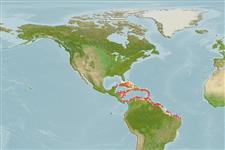Classification / Names
Common names from other countries
Main reference
Size / Weight / Age
Max length : 100.0 cm TL male/unsexed; (Ref. 55); common length : 65.0 cm TL male/unsexed; (Ref. 55); max. published weight: 10.0 kg (Ref. 5217); max. reported age: 18 years (Ref. 55)
Length at first maturity
Lm 43.0, range 79 - 40.6 cm
Environment
Marine; demersal; depth range 26 - 340 m (Ref. 9626), usually 70 - 120 m (Ref. 55)
Climate / Range
Tropical, preferred 27°C (Ref. 107945); 25°N - 19°S, 87°W - 35°W (Ref. 54572)
Distribution
Western Atlantic: throughout most of the Caribbean Sea from Cuba southward to northeastern Brazil. Frequently confused with Lutjanus campechanus. Also referred to as Lutjanus aya by past authors, but Rivas (Ref. 6409) proved that Bodianus aya Bloch, 1790 is not a lutjanid, but probably a sciaenid.
Countries | FAO areas | Ecosystems | Occurrences | Introductions
Short description
Dorsal
spines
(total): 10;
Dorsal
soft rays
(total): 14;
Anal
spines: 3;
Anal
soft rays: 8 - 9. Head short, its dorsal profile somewhat rounded behind eye. Snout short and blunt. Eye large. Preopercular notch and knob weak. Pectoral fins long, reaching level of anus. Scale rows on back rising obliquely above lateral line. Back and upper side deep red; lower sides and belly rosy, with a silvery sheen; the fins mainly red. A small spot is sometimes on the lateral line below the anterior portion of the dorsal fin rays. Young with a rounded black spot on upper side below anterior dorsal soft rays, disappearing with growth.
IUCN Red List Status (Ref. 115185)
Threat to humans
Reports of ciguatera poisoning (Ref. 31172)
Human uses
Fisheries: commercial
More information
ReferencesAquacultureAquaculture profileStrainsGeneticsAllele frequenciesHeritabilityDiseasesProcessingMass conversion
Tools
Special reports
Download XML
Internet sources
Estimates of some properties based on models
Phylogenetic diversity index
PD50 = 0.5000 many relatives (e.g. carps) 0.5 - 2.0 few relatives (e.g. lungfishes)
Trophic Level
3.6 ±0.6 se; Based on diet studies.
Resilience
Low, minimum population doubling time 4.5 - 14 years (K=0.09-0.12; tm=5.5; tmax=18)
Vulnerability
High vulnerability (60 of 100)
Price category
